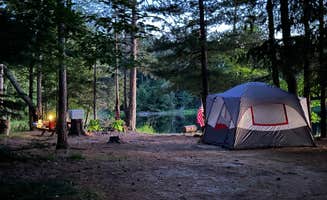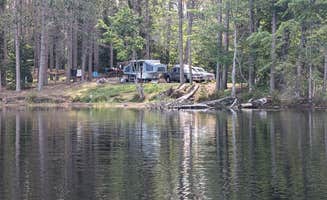Dispersed camping sites in the Chequamegon-Nicolet National Forest near Boulder Junction provide primitive camping experiences with varying levels of accessibility and seasonal considerations. The northern Wisconsin forest contains several small lake campsites within a 15-mile radius of Boulder Junction. Most primitive sites have limited cell service, with Cricket providing occasional single-bar reception in select locations. Winter access remains possible at some sites, though road conditions require appropriate vehicles and preparation.
What to do
Paddle the quiet waters: Three Johns Lake offers a secluded lake experience with a short walk-in access. "Tents only. Short walk to campsite only one on lake. 5 dollar parking national Forest," reports a camper, making it ideal for paddlers seeking solitude.
Hike nearby trail systems: The Hidden Lakes Trail system provides access to numerous primitive campsites. A camper at FR 2140 Dispersed notes, "There is hiking trail access from campsite, but no water access to butternut lake or it would have been 5 star. There is access down the road."
Wildlife viewing opportunities: Loons are common residents on several small lakes. At Woodbury Lake Campsite, visitors can enjoy "a sandy beach great for swimming or paddling" while observing local wildlife.
What campers like
Secluded waterfront access: Robinson Lake Dispersed Campsite features "two sites on lake some distance apart. Sand bottom on shore, picknick table and fire ring. No fee for camping can stay 14 days."
Swimming beaches: Several primitive sites feature natural sand beaches. A camper at Woodbury Lake Campsite mentions, "This remote site has a sandy beach great for swimming or paddling. There is space for a trailer."
Seasonal solitude: Winter camping is possible at select sites. At FR 2140 Dispersed, a visitor reports, "Winter camped here, was a nice spot pic nik table, fire ring, wilderness toilet." Fall offers reduced mosquito activity and fewer visitors at most sites.
What you should know
Road conditions vary significantly: Many access roads require careful navigation. At Bose Lake Campsite, "Road to get in is narrow and pot holed," warns one camper, typical of many dispersed sites in the area.
No-motor restrictions: Several lakes prohibit motorized watercraft. At Harriet Lake Campsite, visitors note it is a "No motor lake," making it suitable for canoes and kayaks only.
Limited facilities: Most sites have fire rings but minimal additional amenities. A camper at FR 2140 explains, "The road is gravel very dusty from traffic," a common characteristic of forest roads during summer months.
Tips for camping with families
Easy access sites for children: Indian Lake provides convenient access for families. "The campsite is just off a paved road making it easily accessible. It's intended for tents, but a small trailer might fit in the parking area," notes one visitor.
Swimming options: Sites with gradual, sandy lake entries work best for younger campers. McKinley Lake Dispersed offers "a single campsite can park next to tent only. Access to lake" making water activities straightforward.
Wildlife education opportunities: Several lakes feature resident loon pairs, offering wildlife viewing for children. Wolf Lake Campsite hosts "a pair of loons that will share their fish and sandy beach," creating memorable nature experiences.
Tips from RVers
Size restrictions are strict: Most sites accommodate only small trailers or pop-ups. At Wolf Lake Campsite, a camper reports, "I had 8 foot pop up could fit a 20 footer easy or tent camp," but this is larger than most sites can handle.
Turning radius limitations: Forest roads often lack turnaround areas for larger vehicles. At Bose Lake, visitors caution the site has "Room for small camper in parking less than 15 foot," with limited maneuvering space.
Leveling challenges: Parking areas at most sites are natural surfaces without grading. Woodbury Lake can "fit trailer in parking area" according to campers, but bringing leveling blocks is advisable for any hard-sided camping units.



